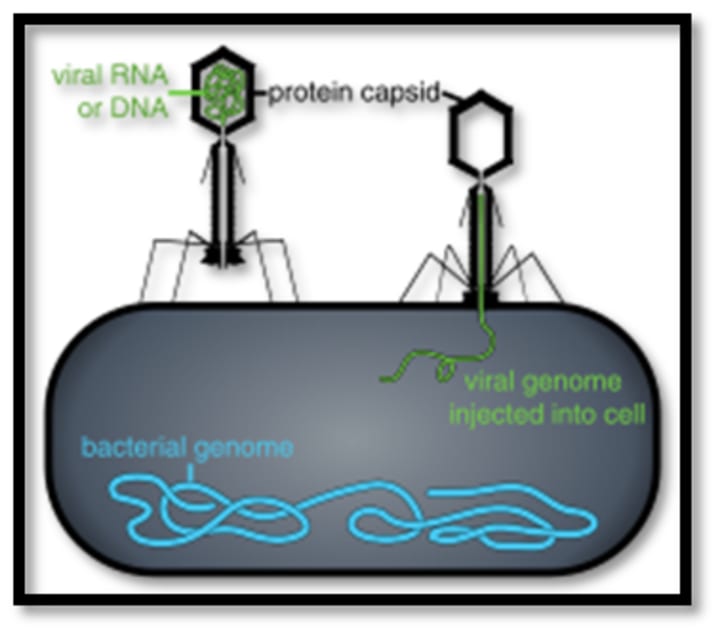Micro-organisms
Viruses, Bacteria, Parasites and fungi.

Viruses, fungi, bacteria, and parasites
The term "germs" refers to pathogenic bacteria or microbes. We typically hear about three main categories of germs: bacteria, viruses, and fungus. Protozoa, the fourth category, are an example of a parasite. There are more parasite species that can spread illnesses.
Viruses
Viruses are the smallest known agents of infectious disease, with prions being the exception. The majority of viruses are essentially spherical and extremely tiny (20–200 nanometers in diameter). They are essentially just a little amount of genetic material covered in a thin protein layer. Additionally, the protein coat of some viruses is encased in a thin, fatty envelope.
Because they are the only class of infectious microorganisms wholly dependent on a host cell for replication, viruses stand out from all other infectious microorganisms. Some scientists contend that viruses are more like complicated molecules than living things since they do not consume food but instead scavenge resources and energy from host cells via compromising cellular circuitry. It is recognised that viruses can affect almost every form of organism on Earth. Bacteriophages are a class of viruses that can even infect bacteria.
Virology is the study of viruses; it is a branch of microbiology. A host cell that has been infected is frequently compelled to quickly make thousands of copies of the original virus.
When not inside an infected cell or in the process of infecting a cell, viruses exist in the form of independent viral particles, or virions, which are made up of (i) the genetic material, or long molecules of DNA or RNA that code for the structure of the proteins by which the virus acts; (ii) a protein coat, the capsid, which surrounds and protects the genetic material; and (iii) an exterior envelope.
These viral particles come in a variety of configurations, from straightforward helical and icosahedral forms to more intricate ones. The majority of virus species have virions that are one hundredth the size of most bacteria and are too small to be seen with an optical microscope.

Replication cycle
A typical virus replication cycle
Since viral populations are acellular, they do not expand through cell division. The host cell is compelled to produce thousands of copies of the original virus quickly after infection.
There are six fundamental stages to their life cycle, however they vary widely between species.
1. Viral capsid proteins and certain receptors on the cellular surface of the host form a specialised binding process known as attachment. A virus's host range and kind of host cell are determined by its specificity. For instance, only a few types of human leucocytes can be infected by HIV. This is due to the fact that the gp120 surface protein interacts particularly with the CD4 molecule, a chemokine receptor that is most frequently located on the surface of CD4+ T-Cells.
2. 1. Viral entrance or penetration happens after attachment: Viral particles enter the host cell through membrane fusion or receptor-mediated endocytosis. Animal cells are not infected the same way that plant and fungus cells are. Most viruses can only enter these cells after causing damage to the cell wall since fungi and plants both have stiff cell walls consisting of cellulose and chitin, respectively.
3. 2. Uncoating is the process of removing the viral capsid, which may be done through simple dissociation, degradation by viral or host enzymes, or both. The final outcome is the release of the viral genomic nucleic acid.
4. 3. Virus replication primarily entails genome multiplication. Viral messenger RNA (mRNA) is created during replication from "early" genes.
5- Assembly - Some protein modification frequently follows the structure-mediated self-assembly of the viral particles. This alteration, which is frequently referred to as maturation, takes place in viruses like HIV after the virus has been expelled from the host cell.[98]
6- Release - Many bacterial and some animal viruses have the ability to be freed from the host cell by lysis, a process that kills the cell by rupturing its membrane and cell wall, if present.

Bacteria
In general, bacteria are ten to one hundred times bigger than viruses. They typically have a length of 1 to 3 microns and resemble spheres or rods. The majority of bacteria are made up of a ring of DNA surrounded by cellular components and enclosed in a fatty membrane.
Similar to humans, they get their energy from foods like proteins, lipids, and sugars. While certain bacteria may survive and grow in the environment, others have evolved to dwell inside of human or animal hosts. While some bacteria may reproduce by doubling their population in fifteen minutes, others take weeks or months to do so.
Numerous illnesses, from minor skin irritation to fatal pneumonia, are brought on by bacteria.
Parasites
The class of creatures known as eukaryotes includes parasites. Because their cells have many characteristics in common with human cells, such as a distinct nucleus, parasites differ from bacteria and viruses.
While certain environmentally resistant kinds of bacteria are almost as little as parasites, parasites are often larger. Some parasites can only reproduce inside their host organisms, whereas others can grow unchecked in the outside environment. Giardia is an example of a single-celled parasite, and parasitic worms are comprised of several cells.Unicellular parasites, such the malaria-causing Plasomdium, are a major cause of illness in underdeveloped nations. The most prevalent causes of parasitic disease in the US are waterborne parasites like Giardia and Cryptosporidium.
Fungi
Fungi come in a variety of forms, sizes, and ways that they might infect people. Fungi are eukaryotes, which means that, like parasites, they have real nuclei and intricate internal structures in their cells. They are typically found as moulds and spores that can survive in harsh environments, but they can also manifest as yeasts that can harm people. Most frequently, fungi cause pneumonia and skin diseases. People with compromised immune systems, such as those with HIV/AIDS, are more vulnerable to fungal illnesses.





Comments
There are no comments for this story
Be the first to respond and start the conversation.